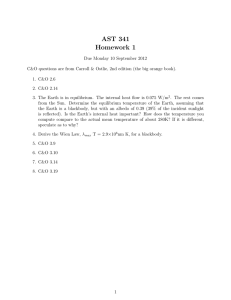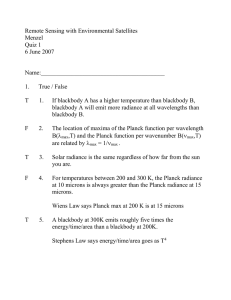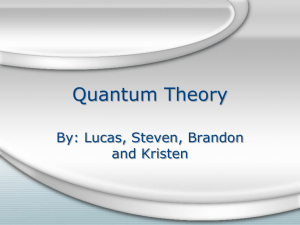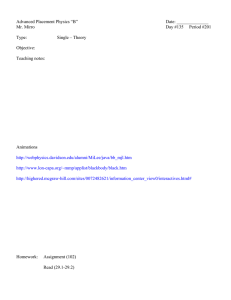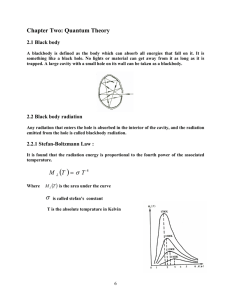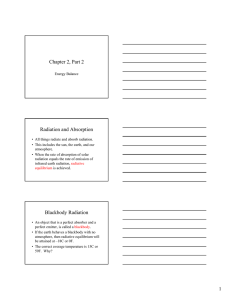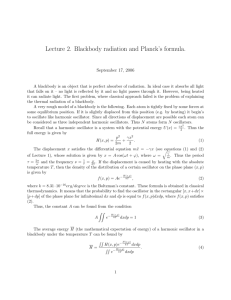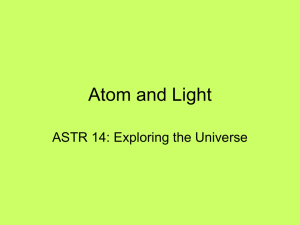The Experimental Basis of Quantum Theory
advertisement
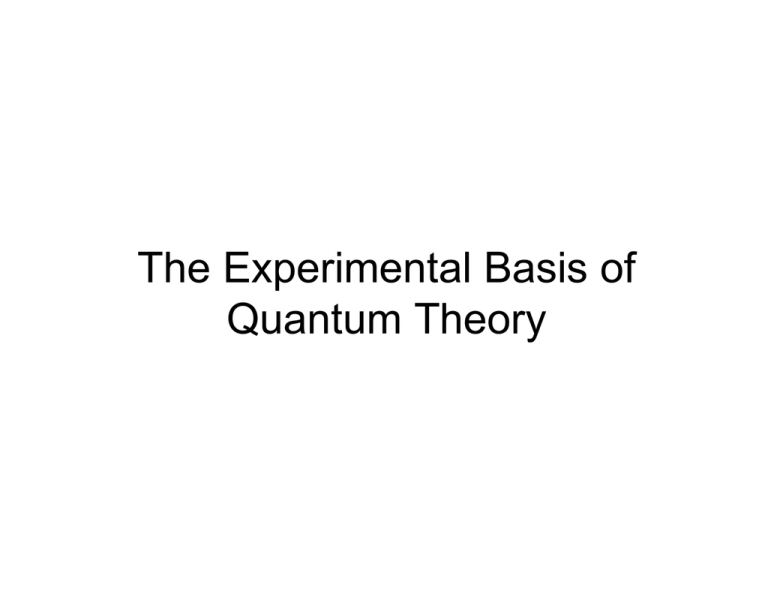
The Experimental Basis of Quantum Theory Preliminary Remarks • New theories do not appear from nowhere, they are usually based on (unexplained) experimental results. • People have to be “ready” for it, e.g. be able to interpret what they see as a new phenomenon and not an experimental flow in their setup. • This also means being aware of new developments in physics Blackbody Radiation Max Plank 1858-1947 Nobel Prize in Physics 1918 Thermal Radiation • Known since centuries that when a material is heated, it radiates heat and its color depends on its temperature • Example: heating elements of a stove: – Dark red: 550ºC – Bright red: 700ºC – Then: orange, yellow and finally white (really hot !) • The emission spectrum depends on the material • Theoretical description: simplifications necessary Blackbody Blackbody ? • A material is constantly exchanging heat with its surrounding (to remain at a constant temperature): – It absorbs and emits radiations – Problem: it can reflect incoming radiations, which makes a theoretical description more difficult (depends on the environment) • A blackbody is a perfect absorber: – Incoming radiations is totally absorbed and none is reflected Blackbody Radiation • Blackbody = a cavity, such as a metal box with a small hole drilled into it. – Incoming radiations entering the hole keep bouncing around inside the box with a negligible change of escaping again through the hole Absorbed. – The hole is the perfect absorber, e.g. the blackbody • Radiation emission does not depend on the material the box is made of Universal in nature λ Wien’s displacement law • The intensity ( , T) is the total power radiated per unit area per unit wavelength at a given temperature • Wien’s displacement law: The maximum of the distribution shifts to smaller wavelengths as the temperature is increased. Visible light: 400 – 700 nm UltraViolet: <400 nm Infrared: >700 nm Empirical Formula Wilhem Wien: Nobel Prize 1911 Exercise • Dominant color of a blackbody at: – T=4000ºC λ = 678 nm RED – T=5000ºC λ = 549 nm GREEN – T=6000ºC λ = 461 nm BLUE Stefan-Boltzmann Law • The total power radiated increases with the temperature: σ • This is known as the Stefan-Boltzmann law, with the constant experimentally measured to be 5.6705 × 10−8 W / (m2 · K4). • The emissivity ( = 1 for an idealized blackbody) is simply the ratio of the emissive power of an object to that of an ideal blackbody and is always less than 1. Understanding the blackbody radiation spectrum • Attempts to fit the low and high wavelength part of the spectrum • Using classical theory of electromagnetism and thermodynamics, Lord Rayleigh comes up with: Rayleigh-Jeans formula • Major flaw at short wavelength (“Ultraviolet catastrophe”) Describing the blackbody emission spectra: one of the outstanding problems at the beginning of the 20th century Two Catastrophes ? • Classical physics: – Emission spectrum: a superposition of electromagnetic waves of different frequencies – Frequencies allowed: standing waves inside the cavity • Equipartition of the energy: ∞ ∞ – Every standing wave carries kT of energy – Flaw: when λ 0, the number of standing waves , leading to E [Ultraviolet Catastrophe] • Failure of classical theories: – The work of Rayleigh-Jeans was considered as state-of-the-art, using well tested theories, which were in very good agreement with experimental results in many other circumstances. – Need for a new theory… Max Planck and the blackbody problem • Max Planck 1858-1947 – Expert in thermodynamics and statistical mechanics – Around 1900: Proposes first an empirical formula (based on real physics) to reproduce both the high and low wavelength parts of the emission spectrum Remarkable agreement with experimental results – Then, works on a theoretical basis of the formula 1918 Nobel Prize Planck’s radiation law • Planck assumed that the radiation in the cavity was emitted (and absorbed) by some sort of “oscillators” contained in the walls. He used Boltzman’s statistical methods to arrive at the following formula: Planck’s radiation law • Planck made two modifications to the classical theory: 1) The oscillators (of electromagnetic origin) can only have certain discrete energies determined by En = nhν, where n is an integer, ν is the frequency, and h is called Planck’s constant. h = 6.6261 × 10−34 J·s. 2) The oscillators can absorb or emit energy in discrete multiples of the fundamental quantum of energy given by ∆E = hν Quantization ! • Blackbody emission spectrum explained by introducing quantization of energy transfers, resolves the ultraviolet catastrophe – Low wavelength High frequency (ν = c/λ) – At small λ, the energy E=hν needed to fill up the “oscillator” states increases. Their probability to be occupied decreases rapidly, e.g. faster than the rate found in the Rayleigh-Jeans formula: no ultraviolet catastrophe. • Very disputed • Planck himself looked for a few years in ways to get h0 without success.
